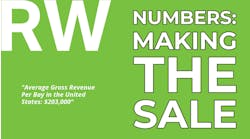Tommy Nickelson spent $3,000–$4,000 on a postcard marketing campaign that ended up with a response rate of less than 10 customers. Not great, and Nickelson knows it—now.
In 2000, when Nickelson purchased his business, Advanced Auto Repair in Denton, Texas, after over a decade as a technician, he wasn’t the marketing master that he is today. Throughout the years, Nickelson has developed a strategy that allows him to bring in 48 new customers and 79 repeat customers per week (weekly tracking is key, he says) and now runs a retention marketing company called Rebate Checks where he helps other shop owners with retaining customers, with one aspect of that being through marketing. Nickelson says he typically budgets 4–6 percent of his annual budget on marketing, but he’ll increase that to 6–8 percent if he’s in a year of growth and plans on adding more technicians.
The right marketing can make or break you and too many owners are throwing money at campaigns that don’t make sense for their shop. These seven deadly marketing sins, outlined by Nickelson and Danielle Wallace, who has spent 14 years in automotive marketing and is a content strategy manager at BG Products, can lead to the demise of your operation.
Sin No. 1: Relying solely on word-of-mouth
This sounds great and, in theory, it is. Why spend money on advertising when your customers do all of the work for you?
You don’t necessarily have to spend a lot of money, explains Wallace, but you do need to spread the word of your business and bring awareness so customers continue to come in. In this day and age, having a web presence is essential. At the very least, have a Google My Business page, Wallace says.
“It’s free, you can get on there and claim your business and be in the primary search results,” Wallace says.
Sin No. 2: Valuing quantity over quality
Sending a coupon to everyone in the city is a waste of money if those people aren’t going to come in, a lesson that Nickelson learned the hard way with his failed postcard marketing campaign. If you target everyone at once, he explains, all of the calls that come in will be based on price. If you’re getting a lot of price shopper phone calls, it may be a good indication that you’re guilty of this.
“You have to find out what it is that your customers are looking for—whether it’s a niche or a specific brand,” Nickelson says. “Play to your niche and once you corner that, go to the next one.”
So, how do you go about doing this? Get to know your customers. Shop owners can figure out who their top customers are and make profiles. Then, they can find resources that allow them to specifically target marketing efforts to those customers. Shop owners can purchase lists that have owners of specific vehicles, for example. Once that’s been obtained, then the marketing efforts can be further tailored to that customer. For example, marketing to customers with a specific vehicle that have children may benefit from a vehicle check-up coupon before a holiday weekend.
Sin No. 3: Practicing poor communication
Many shops have loyalty and referral programs, but customers have no idea. Through BG, there’s a protection plan that its shops have, but Wallace says many shops fail to let customers know about this, which is a mistake because it’s a loyalty tool that helps bring customers in.
Nickelson says his loyalty program has been a great marketing tool for his shop, even though it was a struggle at first. He uses a rebate check program, which he says generates a 15–20 percent response rate. The rebates check are sent to repeat customers as a percentage of what they’ve spent with the shop that year. So, each year, a customer could get a check for, say, $60, Nickelson says, to spend at the shop for an upcoming service.
Sin No. 4: Focusing on selling rather than educating
“In the auto industry, where we’re fighting the stigma of trustworthiness, we have to have content on education and no ulterior motives,” Wallace says.
So, rather than sending out strictly coupons and service reminders, throw in some educational material that shows that you’re invested in your customers more than just after their wallet. A great way to do this is through social media, Wallace says. She suggests taking a technician from the back and having him or her post tips on social media. This will help create trust.
Sin No. 5: Staying in your comfort zone
Think about how different today’s customers are than they were a decade ago. The customer that looked for a repair shop through the Yellow Pages no longer exists. A few years ago, it was all about social media and now, it seems like voice search is the next big trend. Don’t get left behind.
Wallace suggests looking into podcasts and influencer marketing as a way to differentiate. A podcast gets your shop in front of more customers and is a tactic that not many shops are using. When finding an influencer, it could be one of your own employees that serves as the face of your shop.
“Turn your shop from, ‘Dave’s Automotive’ to, ‘Dave, the automotive expert,’” Wallace says.
Doing this creates trust with customers and brings exposure to your shop.
Sin No. 6: Relying too heavily on returning customers
“If you don’t balance your CRM with news customers, you will starve,” Nickelson says.
CRM platforms are great, he explains, but if 80 percent of your business is from repeat customers and all of that work is scheduled up front, you’ll get to a point where there’s a lull because your customers don’t need any service done for a period of time. This needs to be offset with new customers coming in.
“The more repeat customers that you have, the better, but you need to feed the machine,” Nickelson says. “There aren’t many shops that can take a 75 percent hit because they’ve already fixed that much of its customer base.”
Nickelson suggests figuring out how much each new customer costs you to bring in and then figure out a healthy balance between new and returning customers. His shop is at roughly 80 percent returning and 20 percent new and he recommends somewhere close to that range. He doesn’t recommend any more than 35 percent for new customers, and he only recommends going that extreme in a year of growth. Once that’s been figured out, multiply the cost per new customers to how many you want to bring in each month and add that to your marketing budget.
Sin. No. 7: Underestimating the importance of customer service
Good marketing only gets you so far, Nickelson says.
“If they’re [customers] not saying, ‘wow,’ you’re not doing it right,” Nickelson says.
Don’t drop the ball once the customer comes in, or the marketing and work you’ve done will only be good for a one time visit. Make sure to deliver top-notch service and follow-up. Nickelson says he’s amazed by the amount of customers that express how excited they are that someone is calling to follow up on the service that they received. He says it’s a wow factor of which many may not think.



